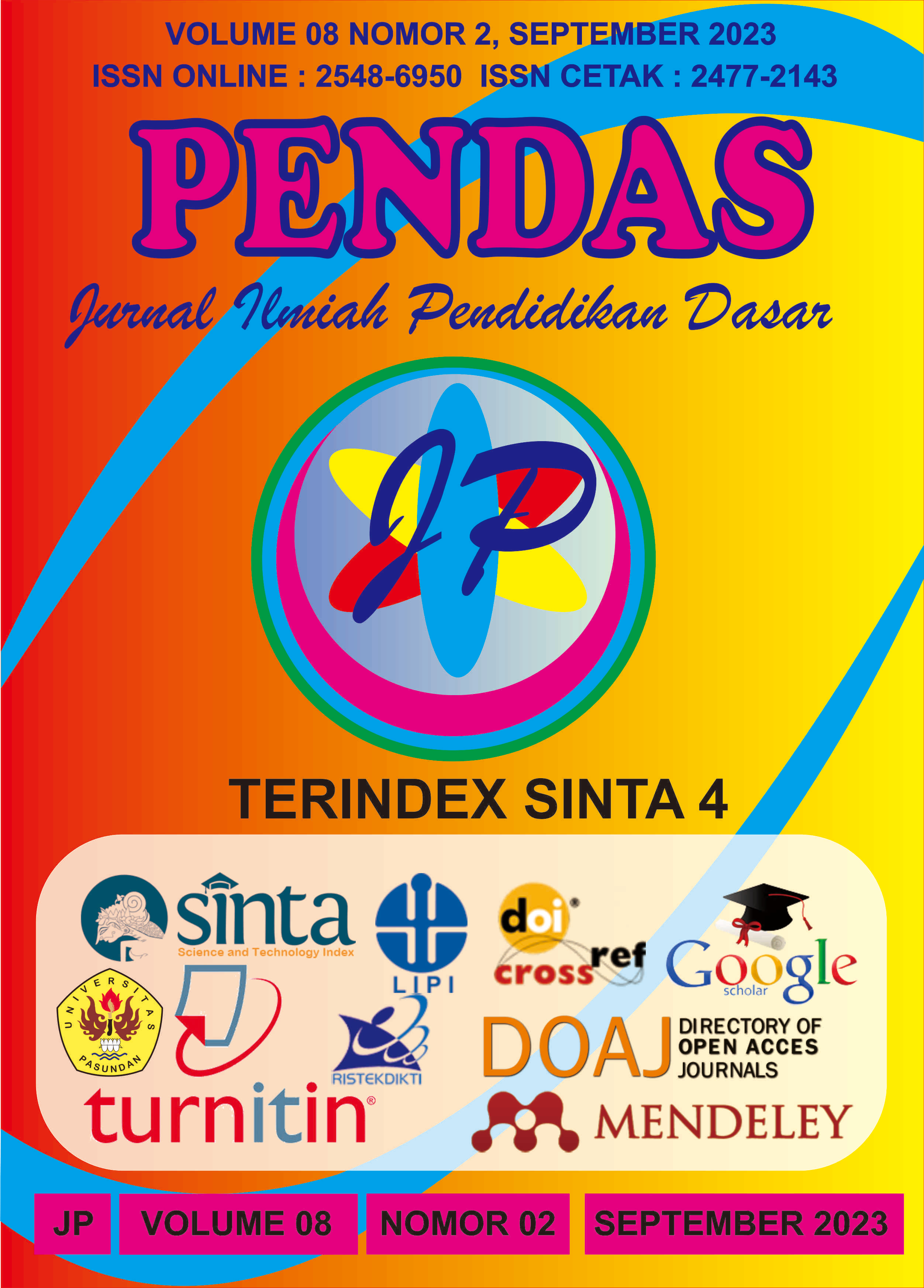PENGEMBANGAN PANDUAN PRAKTIK RAGAM GERAK PADA MAPEL SBDP MATERI SENI TARI UNTUK SEKOLAH DASAR BERBASIS KARTU GAMBAR.
DOI:
https://doi.org/10.23969/jp.v8i2.9841Abstract
This study aims to develop a practice guide for dance art material about various dance moves in the form of picture card teaching materials using research and development methods from Dick and Carey that are appropriate to the stages of learning. The method was used in addition to knowing how the development of picture card teaching materials and how the feasibility of the product developed through the validation of media experts, material experts, linguists, and product trials. The data collection instrument used in this research and development was a questionnaire with qualitative descriptive data analysis. The results of this research and development are in the form of printed teaching materials based on various dance image cards along with descriptions of dance movements. Testing the feasibility of media experts from the due diligence process, it can be seen that teaching materials based on picture cards are very effective for learning after the researcher conducts an initial test (pretest). From this study, it can be seen that there are two hostile ranks and 18 positive ranks from 20 respondents, while in table z, it is -4.678, while the Asym.Sig (2-tailed) value is 0.000 because 0.000 is less than <0. 05, it can be concluded that the hypothesis is accepted. This means that there is feasibility in using picture card-based teaching materials for the process and learning outcomes of dance practice at Muh Demangan Elementary School. Keywords: development of teaching materials, picture cards, dance practice guidesDownloads
References
Agus Suprijono. 2009. Cooperative Learning: Teori dan Aplikasi PAIKEM. Yogyakarta : Pustaka Pelajar
Ahmadi, Farid, D. (2017). Dasar, Pengembangan Media Edukasi “Multimedia Indonesian Culture” (Mic) Sebagai Penguatan Pendidikan Karakter Siswa Sekolah. Jurnal Penelitian Pendidikan, 34(2), 127– 136. https://doi.org/10.15294/jpp.v34i2.12368.
Arfinanti, N. (2018). Pengembangan Media Pembelajaran Matakuliah Metode Numerik dengan Implementasi Scilab Berbantuan Software Latex. Al-Khwarizmi: Jurnal Pendidikan Matematika Dan Ilmu Pengetahuan Alam, 6(2), 121–138. https://doi.org/10.24256/jpmipa.v6i2.370.
Amir, rochyatmo. 1986. Pengetahuan Tari Sebuah Pengantar dalam Pengetahuan Elemen Tari dan Beberapa Masalah Tari. Jakarta: Direktorat Kesenian.
Aspini. (2020). Implementasi Pembelajaran PBL Berbantuan Media Kartu Soal Untuk Meningkatkan Kemampuan HOTS Pada Siswa Kelas VI SD. Jurnal Edutech Undiksha, 8(1), 72–79. https://doi.org/10.23887/jeu.v8i1.27087.
Awalia, I., Pamungkas, A. S., & Alamsyah, T. P. (2019). Pengembangan Media Pembelajaran Animasi Powtoon pada Mata Pelajaran Matematika di Kelas IV SD. Jurnal Matematika Kreatif-Inovatif, 10(1). https://doi.org/10.15294/kreano.v10i1.18534.
Akpan, V. I. 2017. Cell Phones as Effective Learning Resource. Journal of Education, Society and Behavioural Science, 22(4), 1– 8. https://doi.org/10.9734/JESBS/
Cakir, I. 2015. Opinions and Attitudes of Prospective Teachers for the Use of Mobile Phones in Foreign Language Learning. Contemporary Educational Technology, 6(3), 239–255.
Daryanto. (2016). Media Pembelajaran. Gava Media.
Dick, W., Carey, L., & Carey, J. O. 2015. The systematic design of instruction. (J. Johnston, Ed.) (8th ed.). Florida: Pearson.
Jundu, R., Jehadus, E., Nendi, F., Kurniawan, Y., & Men, F. E. (2019). Optimalisasi Media Pembelajaran Interaktif dalam Meningkatkan Kemampuan Matematis Anak di Desa Popo Kabupaten Manggarai. E-Dimas: Jurnal Pengabdian Kepada Masyarakat, 10(2), 221. https://doi.org/10.26877/e- dimas.v10i2.3353.
Jazuli, M. 2008. Paradigma Kontekstual Pendidikan Seni. Semarang: Unesa University Press.
Karo-Karo, I. R., & Rohani, R. 2018. Manfaat media dalam pembelajaran. AXIOM: Jurnal Pendidikan Dan Matematika, 7(1)
Kitao, K., & Kitao, S. K. 1997. The Internet TESL Journal Selecting and Developing Teaching/Learning Materials. Retrieved July 31, 2018, from http://iteslj.org/Articles/Kitao- Materials.html
Liu, S., Keeley, J. W., Sui, Y., & Sang, L. (2021). Impact of distributed leadership on teacher job satisfaction in China: The mediating roles of teacher autonomy and teacher collaboration. Studies in Educational Evaluation, 71. https://doi.org/10.1016/j.stueduc.2021.101099.
Mutiara, D., Zuhairi, A., & Kurniati, S. (2007). Designing, developing, producing and assuring the quality of multi-media learning materials for distance learners : lessons learned from Indonesia’s universities. Turkish Online Journal of Distance Education- TOJDE, 8(April),
Nugraheni, N., Waluya, S. B., & Walid, W. (2021). HOTS study primary teacher education UNNES students based on self-regulated learning. Jurnal Prima Edukasia, 9(1), 127–134. https://doi.org/10.21831/jpe.v9i1.36359.
Prastowo, A. 2014. Pengembangan Bahan Ajar Tematik (1st ed.). Jakarta: KENCANA PRENADAMEDIA GROUP.
Rahmawati, A. (2018). Identifikasi Masalah yang Dihadapi Guru dalam Penerapan Kurikulum 2013. Indonesian Journal of Primary Education, 2(1), 114–123. https://doi.org/10.17509/ijpe.v2i1.14227.
Range, B. G., Young, S., & Hvidston, D. (2013). Teacher perceptions about observation conferences: what do teachers think about their formative supervision in one US school district? School Leadership & Management, 33(1), 61–77. https://doi.org/10.1080/13632434.2012.724670.
Rusliana. 1994. Pendidikan Seni Tari. Bandung: Angkasa.
Setiadi, A., Yuliatmojo, P., & Nurhidayat, D. 2018. Pengembangan Aplikasi Android Untuk Pembelajaran Pneumatik. Jurnal Pendidikan Vokasional Teknik Elektronika, I(1), 1–5.
Downloads
Published
Issue
Section
License
Copyright (c) 2023 Pendas : Jurnal Ilmiah Pendidikan Dasar

This work is licensed under a Creative Commons Attribution 4.0 International License.



















